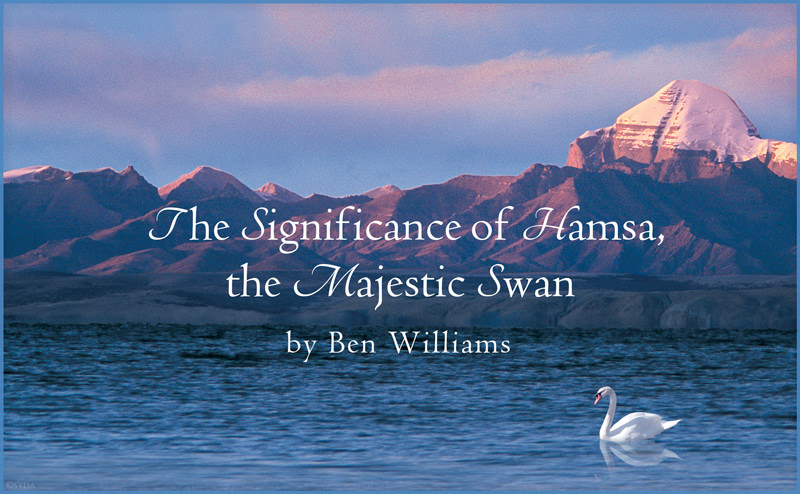Long ago, when I participated in my first Shaktipat Intensive, we were instructed to repeat the
hamsa mantra during meditation. It wasn’t long before I was drawn in to a deep meditative state.
A beautiful image came before my eyes—a large, graceful white swan. The swan remained so steady and one-pointed as it glided along the water. Every now and then, with its long white neck, the swan would dip its head under the water and then surface again. He truly looked like grace in action, and nothing disturbed him. I was that swan, and I knew it, because my vision was looking through his eyes.
Such a valuable lesson! For me, this experience was a wonderful forshadowing of Gurumayi’s Message for 2016:
Move with steadfastness
toward becoming
anchored
in Supreme Joy
I am forever grateful for the blessings of Gurumayi in my life.
Ocean Shores, Australia
I received
shaktipat from Baba Muktananda in September 1976 in France. In the moment of receiving
shaktipat, inside myself I was transformed into a beautiful swan, a serene, royal, peaceful white swan floating easefully on a still, dark blue, eternal lake. The
Hamsa mantra started repeating itself along with my breath.
Having this profound meditation experience was indeed majestic and unforgettable; it was a life-changing moment that started my journey to the true Self.
Frabertsham, Germany
I experienced joy and inspiration when I read that “Gurumayi…is a
paramahamsa who is dedicated to teaching the liberating awareness of
viveka to seekers of the Truth.” It underscored for me that, as a disciple, I need to be just as dedicated to receiving, studying, assimilating, and implementing her teachings.
As a result of listening to Gurumayi’s Message for 2019 and practicing the
Hamsa mantra in meditation, I have noticed that I am more often aware of thoughts, emotions, or reactions to circumstances that result in a feeling of contraction. In these moments, I have been saying to myself that this isn’t who I am, I don’t need to dwell on this. And when I resist, I say to myself that this resistance is also not who I am. Through awareness, I have the power to shift this experience right here and now.
What a blessing to have a Siddha Guru, a
paramahamsa, in this lifetime!
Washington, United States
How could one not naturally love a swan? So graceful, powerful, strong, and compelling. This year in my meditation I have felt myself to be carried by the most beautiful swan. Each powerful beat of her wings has become the very breath that carries me—wings reaching up on the in-breath, pushing down on the out-breath. It is as if the swan takes me deeper into myself, and I feel utterly protected, utterly supported, utterly free.
This commentary adds to my appreciation for both the grace of the breath and the One who teaches me to recognize the truth of it inside myself.
Washington, United States
The image of the swan in connection with the mantra and breath is helpful to me. As I repeat the mantra, I can picture the swan moving effortlessly through water, and this calls to mind serenity and grace within me.
Tennessee, United States
We had rare, abundant snow outside this morning. I took the white snow image into meditation as I focused on the
Hamsa mantra. I experienced my whole heart as filled with the image of a huge swan—at times pure white, at other times appearing translucent. I recognized the immense value of this mantra.
Washington, United States
Reading this exposition, I feel I understand more deeply why I’ve always found swans so captivating. Thinking about such beauty and the swan’s symbolism brings me a feeling of subtle sweetness, of deep quiet—as though the image of a swan is filling the space between my breaths.
Kentucky, United States
One day I brought two swans home, and that same day I found this post on the website! I am so happy. To me, these birds are full of equipoise. I feel I can learn many things from watching them.
Pune, India
It was a happy surprise to receive this beautiful explanation of the significance of the majestic swan. The rural area where I live is one of grassland and water. It is a region where large numbers of wild swans live.
Some years ago, I learned that the swan has a kind of sieve in its mouth which separates clear water from mud. What remains is what nourishes it. Ever since I learned this, I have made it a practice to pay attention to the swans that I meet in nature. Inwardly I greet them, and I pray to develop their way of
viveka in my own life.
Oostzaan, Netherlands
Reading and saying the word
paramahamsa aloud lifts my spirit; my heart expands.
Paramahamsa—so beautiful!
Hinwil, Switzerland
One night in meditation, I had a vision of a swan gliding through blue water. Soon after, I saw the book
I am That by Baba Muktananda with a similar image of a swan on the cover.
I ordered the book, and it arrived in the mail today! I cherish it as a message from the inner Guru to meditate more, focusing on
Hamsa.
Stockholm, Sweden
This comprehensive commentary on
hamsa inspires me to practice the virtues of
hamsa, gracefulness and
viveka, discernment.
Thane West, India



